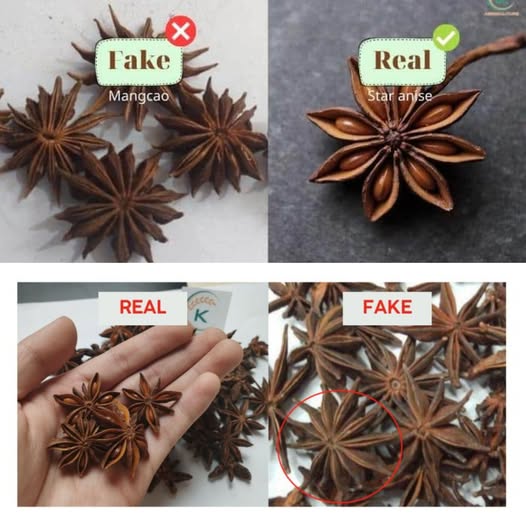Taste the Flavor:
Real Star Anise: Authentic star anise has a bold, sweet, and slightly spicy flavor with a distinct licorice taste. If you chew on a pod, it should leave a lingering, pleasant aftertaste.
Fake Star Anise: Counterfeit versions may lack this bold flavor or taste bland or bitter. Some may not have a licorice-like flavor at all or could have an off-putting taste.
Observe the Seed:
Real Star Anise: The inside of a genuine star anise pod contains shiny, brownish seeds that are small and smooth.
Fake Star Anise: Some fake varieties may contain no seeds or may have irregular, poorly formed seeds that are different in appearance and size from real star anise.
Tips for Serving and Storing:
Serving: Star anise can be used in various dishes, including soups, stews, teas, and spice blends like Chinese five-spice powder. Make sure to use genuine star anise to fully enjoy its flavor and health benefits.
Storing: Store star anise in a cool, dry place away from sunlight to preserve its aroma and flavor. Keep it in an airtight container to prevent it from absorbing moisture or losing its potency. Whole star anise will last longer than ground versions.
Variants:
Whole Star Anise vs. Ground Star Anise: Whole star anise is more flavorful and retains its aroma for a longer period compared to ground star anise. If you can’t find whole pods, ground star anise can be a substitute but may lose its potency over time.
Star Anise vs. Japanese Star Anise: Japanese star anise (Illicium anisatum) is a toxic variety and should be avoided. It has a similar appearance to the edible Chinese star anise but lacks the same culinary uses. Always ensure the star anise you purchase is labeled as “Chinese Star Anise” (Illicium verum) for safe consumption.
Organic Star Anise: If you’re looking for a higher-quality option, choose organic star anise, which is grown without pesticides or chemical fertilizers. Organic star anise typically has a more intense aroma and richer flavor.
FAQ:
How can I tell if my star anise is real or fake?
The best way to identify real star anise is by examining the shape, color, smell, and texture. Real star anise will have a distinct star shape, a reddish-brown color, a strong licorice-like aroma, and a firm texture. Fake versions may appear misshapen, faded in color, or lack the characteristic smell.
Can fake star anise be harmful?
Yes, fake star anise, particularly the Japanese variety (Illicium anisatum), can be toxic if consumed. It’s essential to verify that your star anise is from a reputable source and labeled as Chinese star anise (Illicium verum).
What should I do if I find fake star anise?
If you suspect that you have purchased fake star anise, it’s best to discard it to avoid any potential health risks. Always purchase spices from trusted, reputable vendors, and look for certifications such as organic or non-GMO to ensure authenticity.
Can I use star anise for health purposes?
Yes, star anise is often used in traditional medicine for its digestive and anti-inflammatory properties. It’s known to help with digestive issues, promote relaxation, and provide relief from coughs. Always use fresh, authentic star anise for the best health benefits.
How long does star anise last?
Whole star anise can last up to a year when stored in an airtight container away from direct light and moisture. Ground star anise should be used within 6 months for maximum freshness and flavor.
Conclusion:
Identifying real star anise from fake varieties is essential for ensuring both the quality and safety of the spice you use. By examining the shape, color, smell, and texture of the pods, as well as tasting the flavor, you can confidently choose authentic star anise for your culinary and medicinal needs. Always be cautious when buying spices and purchase them from reputable sources to avoid counterfeit or harmful products. Enjoy the full flavor and benefits of this fragrant spice by ensuring you’re using genuine star anise in your cooking and health routines.
ADVERTISEMENT

